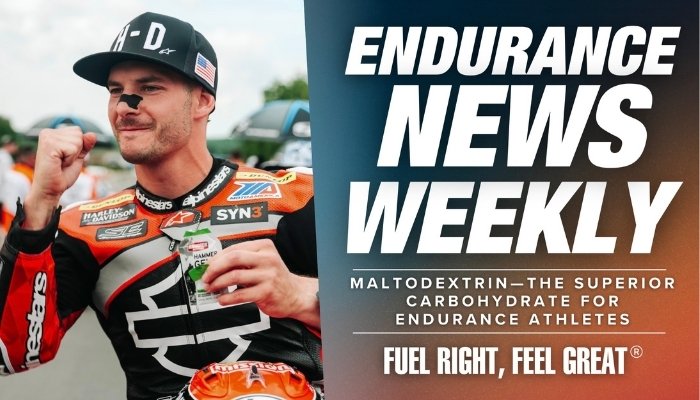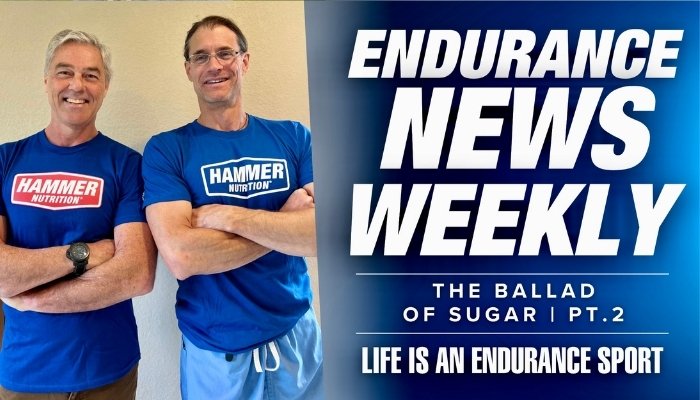BY STEVE BORN
The day before his 88th birthday, Clint Eastwood was asked how me remained so young and active. Eastwood’s reply: “I don't let the old man in.” Love that!
While we can’t halt aging altogether, we may be able to slow the process down—not “letting the old man in” for a while (“old woman” as well, of course)—via several areas, including diet, supplementation, exercise, getting sufficient sleep, and many others far too numerous to list here.
One area in delaying the aging process that’s of importance, especially for athletes, is maintaining muscle strength, the loss of which is formally known as dynapenia. The National Center for Biotechnology Information elaborates:
Dynapenia (pronounced dahy-nuh-pē-nē-a, Greek translation for poverty of strength, power, or force) is the age-associated loss of muscle strength that is not caused by neurologic or muscular diseases. Dynapenia predisposes older adults to an increased risk for functional limitations and mortality. [1]
A study detailed in the peer-reviewed journal Calcified Tissue International and Musculoskeletal Research [2] found a connection between lower levels of vitamin D and a greater risk of developing dynapenia. Data from over 3,200 men and women. Ages 50 and higher, was utilized for this study. None of the participants showed signs of dynapenia as determined by grip strength at the onset of the study. The participants’ serum 25-hydroxyvitamin D levels were also measured at that time, and were categorized as sufficient, insufficient, or deficient. The researchers reassessed participants’ grip strength after a four-year period.
Sufficient – 25-hydroxyvitamin D levels of at least 20 ng/mL
Insufficient – 25-hydroxyvitamin D levels of 12-20 ng/mL
Deficient - 25-hydroxyvitamin D levels of less than 12 ng/mL
IMPORTANT NOTE: Optimal range is between 50–80 ng/mL
The results showed that, compared to the Sufficient group, the Insufficient group had a significant 55% greater risk of developing dynapenia, while the Deficient group had a massive 70% greater risk.
One of the lead researchers, Dr. Tiago da Silva Alexandre, states “Vitamin D is known to participate in various functions of the organism. It’s a hormone and its many roles include helping to repair muscles and releasing calcium for muscle contraction kinetics. It was therefore expected to cause muscle alterations of some kind. That’s exactly what our study proved.” He continued, “Another conclusion to be derived from the results of the study is that it’s important to take vitamin D if you have a deficiency or insufficiency. It’s necessary to explain to people that they risk losing muscle strength if they don’t get enough vitamin D.”
One thing that should catch your eye is that the “sufficient” category started at a level (20 ng/mL) that’s far below the optimal level of 50–80 ng/mL. We don’t know how many of the participants were near or within the optimal level, but just think about how higher the risk of dynapenia would be if the “sufficient” group were not close to or inside the ideal 50-80 ng/mL level.
Summary
Vitamin D is arguably the most researched nutrient of all, and the benefits that optimal levels supply are numerous and wide-ranging. These benefits also include helping us maintain muscle strength as we get older, which is vitally important for everyone, not just athletes.
The best way to know how much vitamin D you need is via a 25-hydroxyvitamin D blood test, also called a 25(OH) D test. For many people, an amount of 2,000 IU (50 mcg) is oftentimes completely sufficient, and for others who may need more, it is an excellent starting point. 2,000 IU (50 mcg) is the amount found in one softgel capsule of EnDuro D. In addition, EnDuro D contains an ideal amount of vitamin K2, which provides its own powerful benefits, while complementing vitamin D perfectly.
REFERENCES
[1] https://www.ncbi.nlm.nih.gov/pmc/articles/PMC3571692/
[2] https://link.springer.com/article/10.1007/s00223-022-01021-8











6 comments
This study, at least as paraphrased here, appears to show correlation but not causality. It would seem to me that another explanation for this correlation would be that the insufficient D and the muscle loss could both be the result of another issue or lifestyle. There could even be a genetic predisposition to both D insufficiency and dynapenia without causality. The only way to establish causality, or at least get closer, would be to design an experiment whereby participants were randomly assigned D supplements or placebos, and all other potential confounders (lifestyle, genetics, etc) were factored out. This conclusion here seems like junk science.
———
Hammer Nutrition replied:
This study did not intend to show causality—that is never mentioned nor alluded to in the research—but instead suggests that there is a correlation between low serum vitamin D levels and an increased risk of dynapenia. Certainly, other factors contribute to this issue, one being decreased physical activity, with another factor, as mentioned in this study, that states, “Accordingly, these findings indicate that the loss of muscle strength in older adults is weakly associated with the loss of lean body mass.” The researchers also noted that nutrients potentially involved in protecting against dynapenia were still emerging. They also mentioned that there were both strengths and limitations in this study, yet still stated:
“Despite [the limitations], the association between 25(OH)D deficiency and the incidence of dynapenia was significant. So we concluded that older adults with serum 25(OH)D levels < 30 nmol/L are at greater risk of the incidence of dynapenia than those with serum levels ≥ 30 nmol/L. However, when we excluded individuals with osteoporosis and those who were taking vitamin D supplementation, the risk threshold for the incidence of dynapenia was higher (≤ 50 nmol/L). Clinical trials that combine resistance exercises and vitamin D supplementation in individuals with dynapenia and 25(OH)D insufficiency or deficiency should be developed to investigate whether this combined therapy increases muscle strength in individuals aged 50 or older.”
On the Linus Pauling Institute website ( https://lpi.oregonstate.edu/mic/micronutrient-inadequacies/overview#vitamin-D) it states that “Dietary intake surveys indicate a high prevalence of vitamin D inadequacy in the US population, with 81% of children and adolescents (age 2-18 years) and 95% of adults not meeting the EAR (Estimated Average Requirement).” The National Institutes for Health ( https://pubmed.ncbi.nlm.nih.gov/21310306/) state, “The overall prevalence rate of vitamin D deficiency was 41.6%, with the highest rate seen in blacks (82.1%), followed by Hispanics (69.2%).” These percentages are extremely high, showing that most of us are deficient in vitamin D. Because of the issues involved with vitamin D deficiency—according to the NIH, “Mounting evidence suggests that vitamin D deficiency could be linked to several chronic diseases, including cardiovascular disease and cancer”—and with there being a connection between vitamin D deficiency and dynapenia, it seems reasonable to suggest that sensible supplementation with vitamin D is merited.
I respectfully suggest that you read the research in its entirety (the link is at the end of the blog post) before concluding that this research “seems like junk science.”
just a question: I thought Vitamin D was soaking up Sunshine. How come Dr’s don’t say anything about muscle strength and declline?
———
Hammer Nutrition replied:
Hi Shirley, thank you for your question. Due to extensive use of sun block and other factors, even people who get a lot of sun can show deficiency. Low levels have typically only been associated with mood, but as we see, there’s a lot more seasons to be sure your Vitamin D levels are good. No disrespect to Dr’s, but usually they only have a couple of weeks of nutrition in school. They are taught to treat symptoms, not causes, with drugs and or surgery. Seeking/maintaining optimal health, longevity and wellbeing are each of our personal responsibility, in my opinion. Which is why we publish articles like this and encourage our clients to educate themselves as best they can from multiple sources. BDF
How was the amount of vitamin K chosen.
Thank you,
Bud Phelan
———
Hammer Nutrition replied:
2000 IU, the amount of vitamin D3 found in one soft gel capsule of EnDuro D, is the amount that Dr. Michael Holick— considered to be the preeminent expert on vitamin D supplementation—generally recommends. He discusses this dosage in his book, The Vitamin D Solution: A 3-Step Strategy to Cure Our Most Common Health Problems, as well as in numerous interviews.
———
Hammer Nutrition replied:
There is a total of 1,680 mcg of vitamin K2 in one soft gel capsule of EnDuro D, split between the two most-studied subtypes of vitamin K2, Menaquinone 4 (MK-4) at 1500 mcg and Menaquinone 7 (MK-7) at 180 mcg. While an extremely high pharmacological dose of 45 mg (45,000 mcg) of MK-4 has been used for the treatment of osteoporosis in Japan, research ( https://pubmed.ncbi.nlm.nih.gov/23702931/, https://pubmed.ncbi.nlm.nih.gov/19352059/) has shown that a lower amount of 1.5 mg (1,500 mcg) is effective. Research ( https://pubmed.ncbi.nlm.nih.gov/23525894/) on MK-7 has shown that 180 mcg/day is effective. Additionally, Dr. Dennis Goodman, author of Vitamin K2: The Missing Nutrient for Heart and Bone Health, suggests amounts between 150 to 180 mcg/day of MK-7.
Thank you, good information, much appreciated!
Nice article. Thank you.